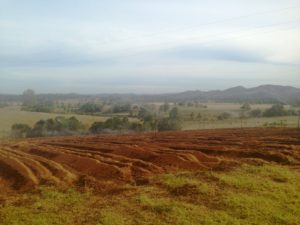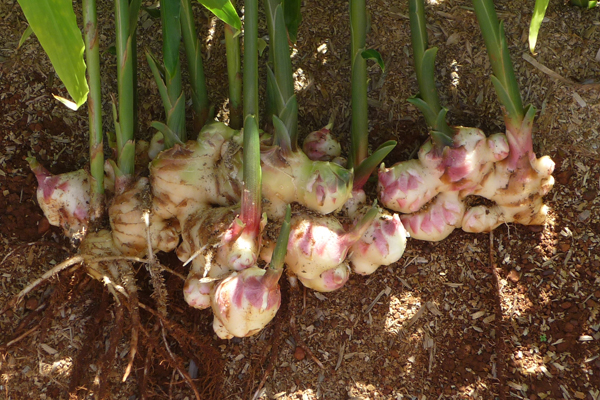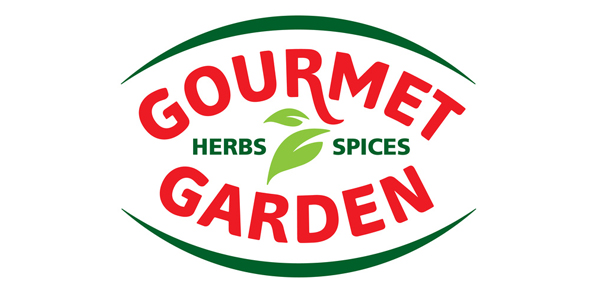AUSTRALIAN GINGER
Enjoy Australian ginger in many ways… here is some information about this humble plant that has such a wide variety of uses. Learn more about how to choose and use ginger and more about its health benefits – read more below.
HISTORY
Despite considerable efforts by governments to persuade farmers to grow ginger commercially, a large-scale Australian ginger industry was not established until the mid-20th century. When the Second World War cut ginger supply from China sales of domestic ginger increased. Five farmers formed a co-op and later built the ‘Merrybud’ Ginger Factory at Buderim, Queensland. At the time it was the only highly-mechanised ginger factory in the world and the only plant in the southern hemisphere where ginger was processed in all forms.
Today the Australian ginger industry is a world leader in producing and bringing food safe quality ginger to the market. The combination of superior quality, food safety regulations and heritage is something of great pride for those involved in the industry.
AGIA would like to acknowledge the influence by Chinese settlers who also brought ginger to Australia in the early 19th Century to continue their culinary and medicinal traditions.
Read more about Ginger and it’s history here.
A YEAR OF GINGER
 Planting
Planting
The ginger plant is a rainforest plant that needs high rainfall and humidity and rich, volcanic soils. In Australia the ginger growing season begins in August when golf ball sized pieces of rhizomes from previous years crop or from a reputable seed ginger grower is put in the ground. The crop is then carefully watered and looked after until February when the paddocks are a sea of one metre high green grass.
By now the plants have formed delicate new rhizomes in large clumps of odd-shaped “hands” under the ground.
Early Harvest

An early harvest takes place in February and March when the rhizomes is smaller, less hot and have minimal fibre content. This makes the ginger ideal for processing.
Late Harvest

In June and August a late harvest takes place. The rhizomes are now larger and the flavour is “hotter”. This late harvest ginger is valued for its high content of oil and oleo-resins.
WHEN IS GINGER IN SEASON?
To meet demand most ginger farmers are now harvesting all year round and fresh ginger can be found in super markets and green grocers at all times. The price for ginger remains relatively consistent for most of the year.
Ginger also is available in a variety of other forms including dried, pickled, preserved, crystallised (or candied) and powdered or ground. Your local super market will stock most of these.
HOW TO CHOOSE AND USE GINGER…
Nothing compare to the taste, texture and health benefits of ginger and nothing compares to the commitments of the Australian Ginger Industry Association to bring the very best ginger in the world to our super markets.
Here is a some helpful information about buying, storing and using fresh ginger.
Where to find ginger?
Fresh ginger is supplied all year round and most major grocery stores and green grocers stock it. Canton (Jumbo) is the most popular variety used in the fresh market.
How to choose ginger?
Fresh ginger comes in young and mature forms. Young ginger has mild flavour and has a pale, thin skin that does not require peeling.
The skin of mature ginger on the other hand is tough and requires peeling. It is either chopped or grated before use. Choose a piece that is firm to the touch, has clean skin and gold skin colour.
How to peel ginger?
The skin is very thin and comes off easily with the right technique. The easiest way to do it is with a spoon. Hold the ginger in your non-dominant hand and run the tip of a spoon down the side and the skin peels right off.
What to do with the peel?
Do not through the peel away, it is edible. Use it to make a broth and then add a couple of teaspoons to juices, steamed veggies or make a nice cup of tea.
How to store ginger?
If you will be using the ginger soon again store it in a zip lock bag at the bottom of you fridge. This way it will stay fresh and crisp for several weeks. If you know that you will not use it for some time you can freeze the ginger and enjoy it for a couple of months. Frozen ginger is easy to grate.
GINGER PRODUCTS
Ginger is available in a variety of forms including fresh, dried, oil, ground, pickled and crystallised (or candied).
FRESH GINGER
Fresh ginger comes in young and mature forms. Young ginger has a mild flavour and has a pale, thin skin that does not require peeling. Mature ginger on the other hand might need peeling and has a stronger flavour.
DRIED GINGER
Dried ginger is available in both whole fingers and slices. Dried roots are sold either with the root skin left on or with the skin peeled off. Dried ginger may be further processed to make ground ginger.
GROUND GINGER
A savoury but slightly sweet, pungent spice that adds a little bit of heat. Used in curries, cakes and biscuits and perfect for Gingerbread men.
GINGER OIL
Ginger oil has a spicy and peppery aroma. It can be rubbed topically with a carrier oil on an area of pain or taken internally to treat health conditions. Ginger oil is also known as the “oil of empowerment”, known to bring on feelings of courageousness and self-assurance.
PICKLED GINGER
Young ginger is generally preferred for pickled ginger because of its tender flesh and natural sweetness. The ginger is thinly sliced and then marinated in a solution of sugar and vinegar. It often accompanies sushi and is served to refresh the palate between courses.
CRYSTALLISED GINGER
Crystallised ginger, or candied ginger, is not only a sweet treat but also an old remedy used to treat nausea, especially during pregnancy. It can be eaten on it’s own or added to cookies and cakes.
~ PROTECTS ~ CALMS ~ ENHANCES ~ SUPPORTS ~ STIMULATES ~ BOOSTS ~
Ginger is one of the most delicious spices on the planet. It has also a very long history of use in various forms of traditional and alternative medicine. It is loaded with nutrients and bioactive compounds (gingerols and shogaols) with incredible antioxidant and anti-inflammatory properties, that have powerful benefits for both your body and brain.
So not only does ginger add distinctive flavour to your cooking, but is also really one of the “super foods”. Ginger may help with:
![]() an upset stomach
an upset stomach
![]() prevent nausea, especially motion and morning sickness
prevent nausea, especially motion and morning sickness
![]() protect the stomach against toxins
protect the stomach against toxins
![]() with weight loss by stimulating metabolism
with weight loss by stimulating metabolism
![]() aid a healthy and complete digestion
aid a healthy and complete digestion
![]() regulate blood sugar and help manage type 2 diabetes
regulate blood sugar and help manage type 2 diabetes
![]() fight infections, such as flu and common cold
fight infections, such as flu and common cold
![]() pain and inflammation associated with arthritis an exercise.
pain and inflammation associated with arthritis an exercise.
Ginger is one of the most fantastic natural ingredients you’ll come across. If you are not
already using ginger in your kitchen, buy some next time you go shopping!
RECIPES
OUR PROCESSORS
AGIA is proud to have a great relationship with the following processors:



